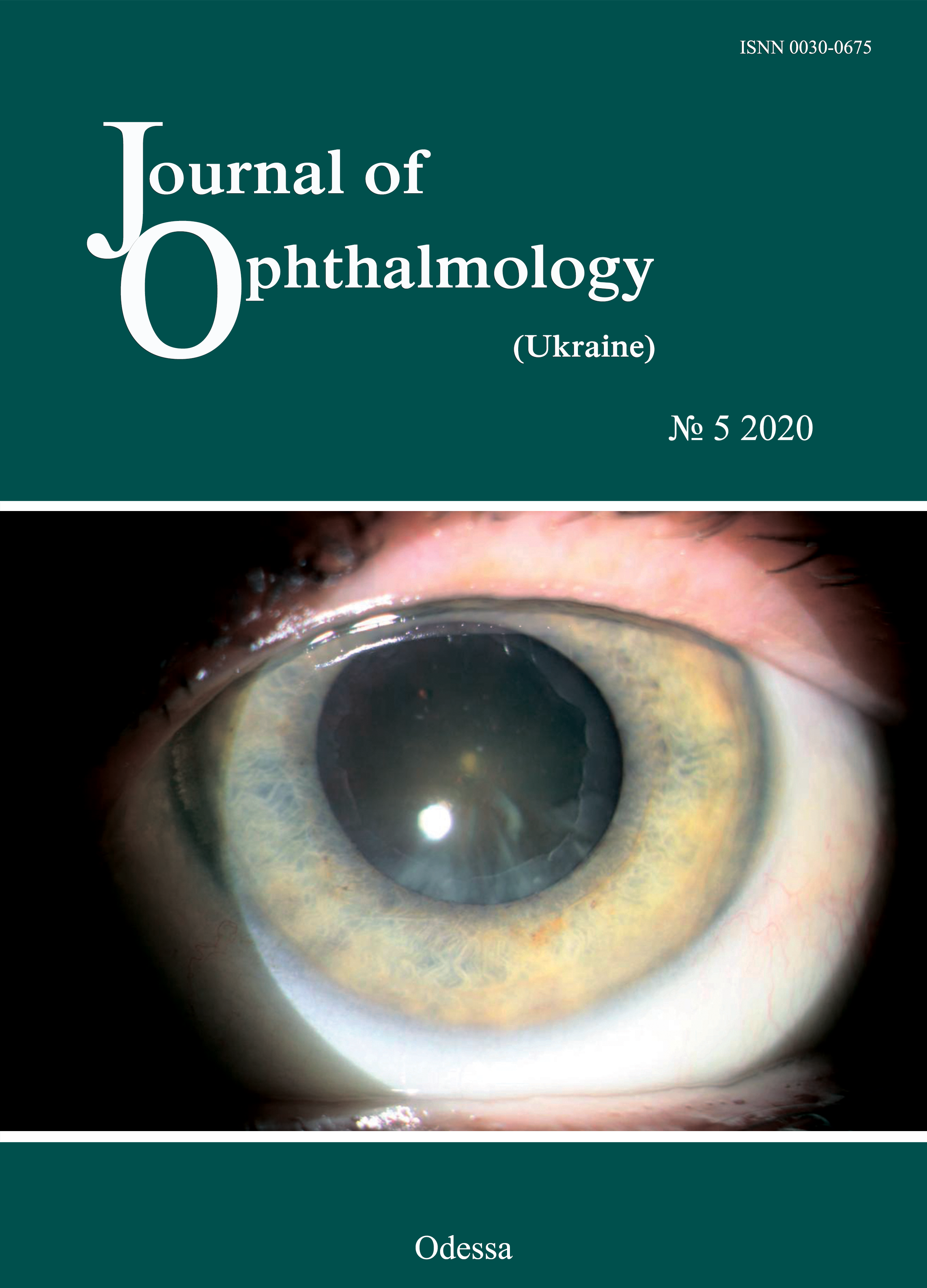A novel concept of differences in pathogenetic mechanism of diabetic retinopathy progression between type 2 diabetes mellitus patients differing in the PPARγ genotype
DOI:
https://doi.org/10.31288/oftalmolzh202053642Keywords:
diabetic retinopathy, L-FABP, polymorphismAbstract
Background: It is important to study cellular circulation of L-FABP-associated fatty acids (FA) and their oxidation through the classical pathway with activation of the PPARγ gene and under conditions of impaired lipid metabolism.
Purpose: To investigate the pathogenetic mechanisms of diabetic retinopathy (DR) progression in type 2 diabetes mellitus (T2DM) patients differing in the PPARγ genotype.
Material and Methods: This study involved 101 T2DM patients (101 eyes) with different stages of diabetic retinopathy (DR) as assessed by the ETDRS scale and 40 non-diabetics (controls) who were comparable in age, gender and body mass index. The polymorphism was detected by real-time PCR on a Real-Time Gene Amp® PCR System 7500 (Applied Biosystems). ELISA was used to determine serum L-FABP levels with Human L-FABP ELISA kit (Hycult Biotech).
Results: Our findings allowed for developing a concept of differences in pathogenetic mechanisms of DR progression between patients differing in the PPARγ genotype. Among carriers of the wild-type PPARγ genotype, DR as a complication of diabetes develops as a result of chronic inflammation and through PPARγ-dependent gene transcription, expression of the enzymes that oxidize arachidonic acid, and synthesis of the metabolites affecting the endothelium, platelets, the blood clotting system, etc. In diabetic PPARγ polymorphism carriers, PPARγ-dependent gene transcription is inhibited, and fatty acids are utilized in the cell via other L-FABP mechanisms, which results in activation of direct peroxisomal oxidation and increased oxidative stress-induced inflammation.
A new insight into differences in pathogenetic mechanisms of DR progression between T2DM patients differing in the PPARγ genotype provides the basis for subsequent clinical development of advanced, customized management schemes for patients with different DR stages to prevent further retinal damage.
References
1.Balashevich LI, Izmailov AS. [Diabetic ophthalmopathy]. St. Petersburg: Chelovek; 2012. Russian.
2.Shilova OG. [New aspects of the pathogenesis and treatment of diabetic retinopathy]. International journal of endocrinology. 2012;4(44). Russian.
3.Cheung N, Mitchell P, Wong TY. Diabetic retinopathy. Lancet. 2010;376(9735):124-36. https://doi.org/10.1016/S0140-6736(09)62124-3
4.Mogilevskyy SIu , Bushuieva OV, Natrus OV. [Features of diabetic retinopathy in patients with diabetes mellitus 2 type]. Arkhiv Oftal'mologii Ukrainy. 2017;5(1):37-44. Ukrainian. https://doi.org/10.22141/2309-8147.5.1.2017.172575
5.Chernobryvtsev O.P. The endothelial dysfunction factors in diabetes mellitus 2 type. F J Educ Health Sport. 2019; 9 (1) : 410-416; http://dx.doi.org/10.5281/zenodo.2608956
6.Benarous R, Sasongko MB, Qureshi S, et al. Differential association of serum lipids with diabetic retinopathy and diabetic macular edema. Invest Ophthalmol Vis Sci. 2011;52(10):7464-9. https://doi.org/10.1167/iovs.11-7598
7.Cetin EN, Bulgu Y, Ozdemir S, et al. Association of serum lipid levels with diabetic retinopathy. Int J Ophthalmol. 2013;6(3):346-9.
8.Rema M, Srivastava BK, Anitha B, et al. Association of serum lipids with diabetic retinopathy in urban South Indians - the Chennai Urban Rural Epidemiology Study (CURES) Eye Study-2. Diabet Med. 2006; 23(9):1029-36. https://doi.org/10.1111/j.1464-5491.2006.01890.x
9.Grimaldi PA. Peroxisome proliferator-activated receptors as sensors of fatty acids and derivatives. Cell Mol Life Sci. 2007 Oct;64(19-20):2459-64.https://doi.org/10.1007/s00018-007-7278-5
10.Altshuler D, Hirschhorn JN, Klannemark M, Lindgren CM, Vohl M-C, et al. The common PPARγ Pro12Ala polymorphism is associated with decreased risk of type 2 diabetes. Nat Genet. 2000 Sep;26(1):76-80.https://doi.org/10.1038/79216
11.Petr M, Stastny P, Zajac A, et al. The Role of Peroxisome Proliferator-Activated Receptors and Their Transcriptional Coactivators Gene Variations in Human Trainability: A Systematic Review. Int J Mol Sci. 2018 May 15;19(5):1472.https://doi.org/10.3390/ijms19051472
12.Esteves A, Ehrlich R. Invertebrate intracellular fatty acid binding proteins. Comp Biochem Physiol C Toxicol Pharmacol. Mar-Apr 2006;142(3-4):262-74.https://doi.org/10.1016/j.cbpc.2005.11.006
13.Choromańska B, Myśliwiec P, Dadan J, Hady HR, Chabowski A. The clinical significance of fatty acid binding proteins. Postepy Hig Med Dosw (Online). 2011 Nov 24;65:759-63.https://doi.org/10.5604/17322693.966983
14.Natrus LV, Gayova LV, Byjhovets MYu, Osadchuk YuS, Konovalov SE. [The value of regulatory effects on lipid metabolism in complicated type 2 diabetes mellitus]. Phyziologichnyi zhurnal. 2020;66(1):25-34. Ukrainian.https://doi.org/10.15407/fz66.01.025
15.Rykov SO, Bykhovets MIu, Natrus LV. [Influence of L-FABP expression and fatty-acid composition of food on the lipid metabolism in patients with different degree of diabetic retinopathy and diabetes mellitus type 2]. Arkhiv Oftal'mologii Ukrainy. 2019; 7(3):27-36. Ukrainian.
16.Rykov SO, Natrus LV, Bykhovets MIu. PPARγ-mediated differences in energy substrate among T2DM patients differing in the stage of diabetic retinopathy. J Оphthalmol (Ukraine). 2019;6:7-14.https://doi.org/10.31288/oftalmolzh20196714
17.Atshaves BP, Martin G, Hostetler HA, et al. Liver Fatty Acid Binding Protein and Obesity. J Nutr Biochem. 2010 Nov;21(11):1015-32.https://doi.org/10.1016/j.jnutbio.2010.01.005
18.Peng X, Wu Y, Zhu Y, Huang R. Association of a Human FABP1 Gene Promoter Region Polymorphism with Altered Serum Triglyceride Levels. PLoS ONE. 2015 Oct 6;10(10):e0139417.https://doi.org/10.1371/journal.pone.0139417
19.Wang Gu Qi, Bonkovsky HL, de Lemos A, Burczynski FJ. Recent insights into the biological functions of liver Fatty Acid Binding Protein 1. J Lipid Res. 2015 Dec;56(12):2238-47.https://doi.org/10.1194/jlr.R056705
20.Verma S, Anderson TJ. Fundamentals of endothelial function for the clinical cardiologist. Circulation. 2002 Feb 5;105(5):546-9.https://doi.org/10.1161/hc0502.104540
21.Mogilevskyy SYu, Panchenko YuO, Ziablitsev SV, Natrus LV. [Disturbed platelet aggregation as a factor of diabetic maculopathy and diabetic macular edema in patients with nonproliferative diabetic retinopathy in type 2 diabetes mellitus]. Arkhiv Oftal'mologii Ukrainy. 2018; 6(3):26-31. Ukrainian.
22.Mokrii YaV, Ziablitsev SV. [Effect of Pro12Ala polymorphism of PPARG gene on lipid peroxidation and antioxidant defense in patients with type 2 diabetes depending on the duration of the disease]. Patologiia. 2016;2(37):52-7.
23.Shi J, Zhang Y, Gu W, Cui B, Xu M, Yan Q, et al. Serum liver fatty acid binding protein levels correlate positively with obesity and insulin resistance in Chinese young adults. PLoS ONE. 2012;7(11): e48777.https://doi.org/10.1371/journal.pone.0048777
24.Odegaard AO, Jacobs DR, Sanchez OA, et al. Oxidative stress, inflammation, endothelial dysfunction and incidence of type 2 diabetes. Cardiovasc Diabetol. 2016 Mar 24;15:51.https://doi.org/10.1186/s12933-016-0369-6
25.Su Y, Liu XM, Sun YM, Jin HB, Fu R, Wang YY, et al. The relationship between endothelial dysfunction and oxidative stress in diabetes and prediabetes. Int J Clin Pract. 2008 Jun;62(6):877-82.https://doi.org/10.1111/j.1742-1241.2008.01776.x
Downloads
Published
How to Cite
Issue
Section
License
Copyright (c) 2025 Л. В. Натрус, С. Ю. Могілевський, Т. І. Панова, С. О. Риков, М. Ю. Биховець

This work is licensed under a Creative Commons Attribution 4.0 International License.
This work is licensed under a Creative Commons Attribution 4.0 International (CC BY 4.0) that allows users to read, download, copy, distribute, print, search, or link to the full texts of the articles, or use them for any other lawful purpose, without asking prior permission from the publisher or the author as long as they cite the source.
COPYRIGHT NOTICE
Authors who publish in this journal agree to the following terms:
- Authors hold copyright immediately after publication of their works and retain publishing rights without any restrictions.
- The copyright commencement date complies the publication date of the issue, where the article is included in.
DEPOSIT POLICY
- Authors are permitted and encouraged to post their work online (e.g., in institutional repositories or on their website) during the editorial process, as it can lead to productive exchanges, as well as earlier and greater citation of published work.
- Authors are able to enter into separate, additional contractual arrangements for the non-exclusive distribution of the journal's published version of the work with an acknowledgement of its initial publication in this journal.
- Post-print (post-refereeing manuscript version) and publisher's PDF-version self-archiving is allowed.
- Archiving the pre-print (pre-refereeing manuscript version) not allowed.












